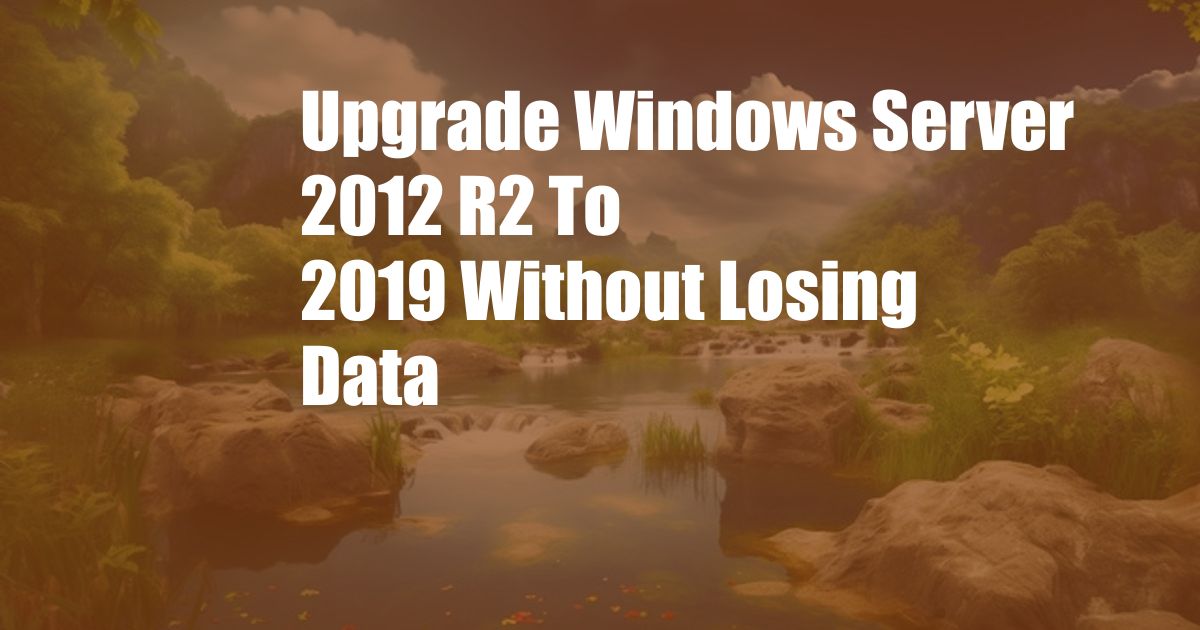
Upgrading Windows Server 2012 R2 to 2019: A Comprehensive Guide Without Data Loss
Embarking on a server upgrade journey? I recently faced the same challenge, upgrading our production server from Windows Server 2012 R2 to 2019. It was a critical task, and data loss was a frightening possibility. After meticulously researching and planning, I executed the upgrade seamlessly, preserving all our precious data. Let me share my experience and guide you through the intricacies of this upgrade, ensuring you navigate it with confidence and data integrity.
Before proceeding, it’s imperative to acknowledge that this upgrade is non-reversible. Once your server is upgraded to Windows Server 2019, there’s no turning back. Therefore, thorough planning and testing are vital before initiating the upgrade process.
Compatibility and System Requirements
Before embarking on the upgrade journey, it’s essential to verify the compatibility of your existing infrastructure with Windows Server 2019. Microsoft provides a comprehensive list of supported hardware, software, and applications on its official website. Additionally, ensure your server meets the minimum system requirements for Windows Server 2019, including processor speed, memory, and storage capacity.
Data Backup and Recovery Strategy
Data loss during an upgrade is a nightmare no administrator wants to experience. To mitigate this risk, implement a robust backup and recovery strategy before initiating the upgrade. Create full backups of your server using a reliable backup solution. Consider storing these backups both locally and off-site for added security. By having a comprehensive data protection plan in place, you can rest assured that your critical data is safeguarded in the event of any unforeseen circumstances.
Step-by-Step Upgrade Process
With your compatibility checks and data backups in place, you’re ready to initiate the upgrade process. Follow these steps meticulously to ensure a smooth transition:
- Install Windows Server 2019 on a separate server: To minimize disruption to your production environment, it’s recommended to set up a separate server for the upgrade process. Install Windows Server 2019 on this dedicated server.
- Prepare the target server: Migrate all roles and services from your existing server to the newly installed Windows Server 2019 machine. This involves transferring Active Directory, DNS, DHCP, and any other essential services.
- Test the new server: Thoroughly test the migrated roles and services on the new server to ensure everything is functioning correctly. This step helps identify and resolve any issues before decommissioning the old server.
- Decommission the old server: Once you’re confident that the upgraded server is stable and performing as expected, you can decommission the old server running Windows Server 2012 R2. Transfer any remaining data or applications to the new server as needed.
Tips and Expert Advice
Based on my experience, here are additional tips to enhance your upgrade journey:
- Create a detailed upgrade plan: Outline each step of the upgrade process, including the order of tasks, timelines, and potential risks. This plan serves as a roadmap, guiding you through the upgrade.
- Engage with Microsoft support: Don’t hesitate to reach out to Microsoft’s support team if you encounter any difficulties or have specific questions. They possess invaluable expertise and can provide timely assistance.
- Monitor the upgrade process: Monitor the upgrade process closely, tracking its progress and identifying any potential issues. This enables prompt troubleshooting and minimizes downtime.
Frequently Asked Questions (FAQs)
Q: Can I upgrade directly from Windows Server 2012 R2 to 2019?
A: No, a direct upgrade from Windows Server 2012 R2 to 2019 is not supported. You must first upgrade to Windows Server 2016 and then from 2016 to 2019.
Q: Can I perform an in-place upgrade?
A: No, an in-place upgrade is not recommended when upgrading from Windows Server 2012 R2 to 2019. It’s safer and more reliable to perform a clean installation on a separate server.
Q: How long does the upgrade process typically take?
A: The upgrade duration varies depending on the size and complexity of your server. However, plan for several hours to a full day to complete the entire process.
Q: What is the best way to ensure data integrity during the upgrade?
A: Implement a robust backup and recovery strategy before initiating the upgrade. Create full backups of your server and store them both locally and off-site. This ensures data can be restored if any issues arise during the upgrade.
Conclusion
Upgrading Windows Server 2012 R2 to 2019 can be a daunting task, but with careful planning and execution, you can navigate it successfully without data loss. By adhering to the steps outlined in this guide, leveraging expert advice, and addressing FAQs, you can enhance the reliability, security, and performance of your server infrastructure.
Are you interested in exploring other aspects of server upgrades or have additional questions about this topic? Let us know in the comments below, and we’ll be happy to provide further assistance.